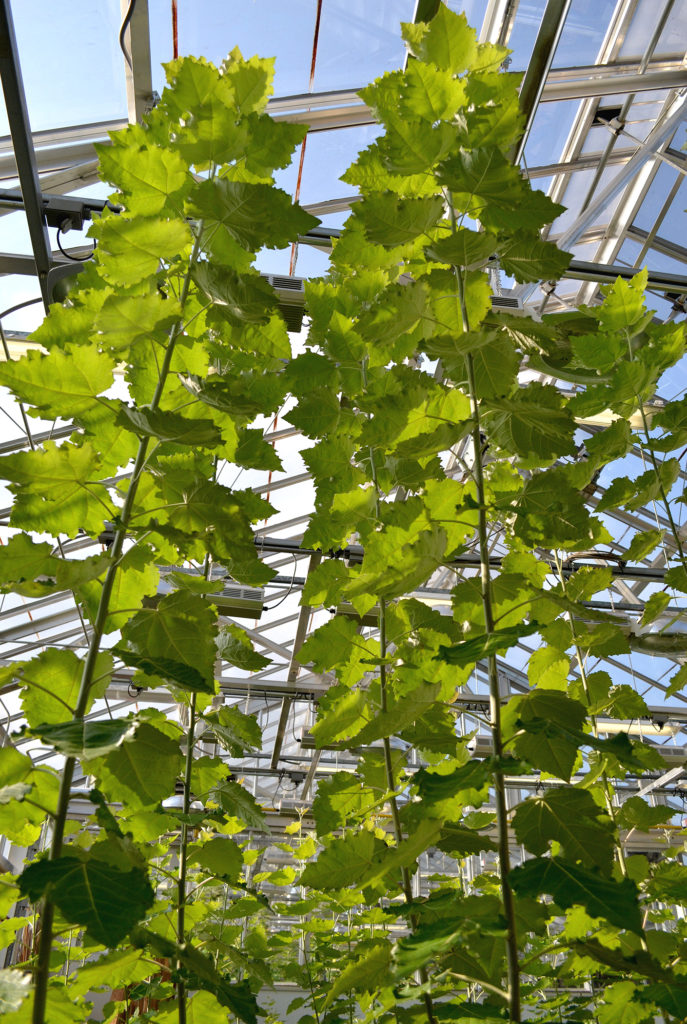Athens, Ga. – Researchers at the University of Georgia think they’ve come up with a system to identify the genes in trees responsible for stress tolerance, which includes everything from extreme temperatures to disease. Now they’re using a new $490,000 grant to identify those genes and figure out how they work.
Identifying those stress-control genes and understanding their function could help create trees that can resist the very things that can kill them, said C.J. Tsai, the lead researcher on the project.
Tsai, a Georgia Research Alliance Eminent Scholar and professor with joint appointments in UGA’s Warnell School of Forestry and Natural Resources and the department of genetics in the Franklin College of Arts and Sciences, has been working for years on ways to create better-growing threes. Key to that is making them more resistant to stressful scenarios like extreme temperatures, disease and drought—but first they need to zero in on the genes that help with that.
“Successfully manipulating one or more of the genes under stressful scenarios could lead to better-growing trees, and the results could also be translated to food crops,” said Tsai, who is also director of the Plant Center at UGA. “The implications of this project could be far-reaching.”
Tsai and her team already have one candidate gene family from a previous study. The nucleoredoxin genes produce small redox proteins involved in cellular redox regulation. These genes were turned on when they increased salicylic acid in poplars.
While they gear up to identify additional candidates, the team will manipulate the nucleoredoxin genes to see the effects on plant stress response.
This project, funded by the U.S. Department of Agriculture, follows a previous study in which Tsai’s team reported that the levels of salicylic acid—a naturally occurring chemical that protects plants from harmful environmental changes—could be greatly increased in poplar trees without stunting growth, which had been a common problem in other plants. Those findings are valuable to this new project, she said.
Salicylic acid is very important to plants because it regulates processes like photosynthesis and defenses against abiotic and biotic stresses—temperature, drought and disease.
“All those stresses promote the generation of damaging oxidants, and salicylic acid is thought to mitigate some of the damaging effects,” Tsai said.
In the previous study, they identified many metabolites and genes that responded to increased salicylic acid.
“It turned out that many of those genes and metabolites were also increased when control trees were grown under heat stress,” Tsai explained. “That’s when we realized that trees overproducing salicylic acid created an opportunity for identifying novel stress-mitigating genes. It’s like these trees have been ‘stress-primed’ by salicylic acid.”
In the new project, Tsai and fellow UGA researchers Scott Harding and Liangjiao Xue, also dually housed in Warnell and the genetics department, and Magdy Alabady in the plant biology department will compare tree responses to heat, drought and elevated levels of salicylic acid to identify genes that act downstream of salicylic acid to trigger defense. They also will study the involvement of small RNAs in this regulation.
RNAs are molecules that convey genetic information from DNA into proteins. Unlike typical genes that code for proteins, small RNA genes produce only small RNAs, but no proteins. The small RNAs are known to play important roles in plant defense as well as in animals by regulating the function of other genes.
By integrating the information they can obtain about gene expression, metabolite profiling and small RNA regulation from these trees, the researchers hope to identify novel cascades of cellular events that regulate plant stress tolerance.
Tsai said poplars were chosen for the studies because of their naturally high levels of salicylic acid compared to other plants, and also because they are a common biofuel feedstock.
Tsai’s team is involved in two other new USDA grants that could have far-reaching implications:
• Her lab is collaborating with scientists at Penn State University, who are looking at how poplar trees respond to the Asian longhorned beetle, one of the most threatening invasive pests in the U.S. Tsai and Harding will receive about $100,000 from a $450,000 grant for the project, led by Penn State’s Kelli Hoover. They’ll be analyzing tissue samples for differences in a class of phenolic glycosides between American and Asian poplars to identify clues that would explain why the exotic tree is resistant to the beetle but native trees are not.
• With a $100,000 exploratory grant, Tsai and collaborators Alabady and Xue are investigating why some trees like poplar, oak and cherry flower early in the spring without leaves, while others like eucalyptus, chestnut and crepe myrtles don’t flower until much later and require the presence of leaves. The new grant will allow them to compare pollen gene expression profiles of the early- and late-flowering tree species. They are particularly interested in carbohydrate metabolism genes—genes involved in synthesis, transport and use of sugars—because early- and late-flowering trees need to obtain sugars through different pathways to sustain the pollen development.
The findings could have a significant impact on multiple research fields, Tsai said.
“Flowering is key to breeding and crop productivity and is highly sensitive to climate change and plays many ecological roles through its interaction with bees and insects,” she said. “Flower development is also an important focus of basic research, and most of our knowledge about flower development comes from studies with annual plants, such as petunias and snapdragons. However, trees grow and reproduce for decades in harsh and changing environments, and how they manage their resources to ensure their reproductive success needs to be better understood.”
